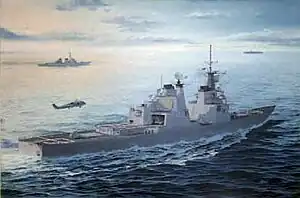Cruiser Baseline
The cruiser baseline (CGBL) was a design study for a ship that has the combat capabilities of VLS-capable Ticonderoga-class cruiser (CG-52 onwards) while designing the hull to DDG-51 (Arleigh Burke-class destroyer) standards and technology. The resulting design was considerably larger than the Ticonderoga-class design, owing to increased margins and allowances for weight and mission growth.[1]
 Artist conception of the Cruiser Baseline by Richard Allison | |
| Class overview | |
|---|---|
| Name | Guided missile cruiser (CG) |
| Builders | Never built |
| Operators | |
| General characteristics | |
| Type | Guided missile cruiser based on combat capabilities of Mk. 41-equipped Ticonderoga-class cruiser (CG-52) |
| Displacement | 13,675 long tons (13,894 t) (full load) |
| Length | 620 ft (189.0 m) |
| Beam | 69.0 ft (21.0 m) |
| Propulsion | 4 × General Electric LM2500 gas turbines, two shafts, 105,000 shp (78 MW) |
| Speed | 30.5 knots (56.5 km/h) |
| Sensors and processing systems | Same as CG-52 |
| Armament | Same as CG-52 |
Notes
- Friedman, Norman (1984). U.S. CRUISERS An Illustrated Design History. Annapolis, Maryland: Naval Institute Press.
This article is issued from Wikipedia. The text is licensed under Creative Commons - Attribution - Sharealike. Additional terms may apply for the media files.